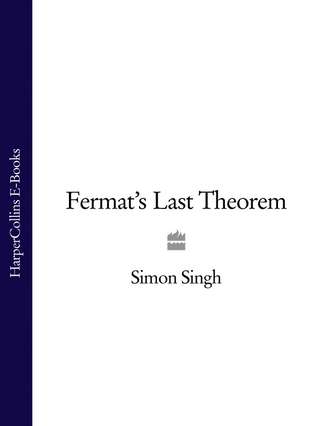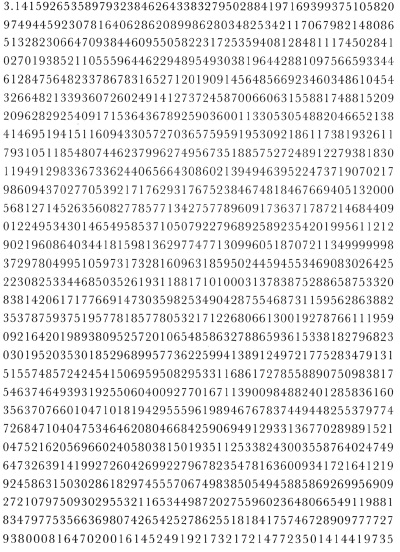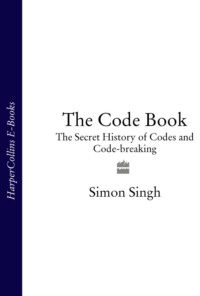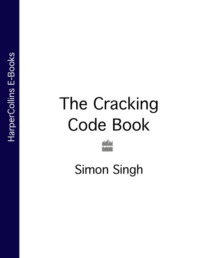
Полная версия
Fermat’s Last Theorem
Fermat and Pascal founded the essential rules which govern all games of chance and which can be used by gamblers to define perfect playing and betting strategies. Furthermore, these laws of probability have found applications in a whole series of situations, ranging from speculating on the stock market to estimating the probability of a nuclear accident. Pascal was even convinced that he could use his theories to justify a belief in God. He stated that ‘the excitement that a gambler feels when making a bet is equal to the amount he might win multiplied by the probability of winning it’. He then argued that the possible prize of eternal happiness has an infinite value and that the probability of entering heaven by leading a virtuous life, no matter how small, is certainly finite. Therefore, according to Pascal’s definition, religion was a game of infinite excitement and one worth playing, because multiplying an infinite prize by a finite probability results in infinity.
As well as sharing the parentage of probability theory, Fermat was deeply involved in the founding of another area of mathematics, calculus. Calculus is the ability to calculate the rate of change, known as the derivative, of one quantity with respect to another. For example, the rate of change of distance with respect to time is better known simply as velocity. For mathematicians the quantities tend to be abstract and intangible but the consequences of Fermat’s work were to revolutionise science. Fermat’s mathematics enabled scientists to better understand the concept of velocity and its relation to other fundamental quantities such as acceleration – the rate of change of velocity with respect to time.
Economics is a subject heavily influenced by calculus. Inflation is the rate of change of price, known as the derivative of price, and furthermore economists are often interested in the rate of change of inflation, known as the second derivative of price. These terms are frequently used by politicians and the mathematician Hugo Rossi once observed the following: ‘In the fall of 1972 President Nixon announced that the rate of increase of inflation was decreasing. This was the first time a sitting president used a third derivative to advance his case for re-election.’
For centuries Isaac Newton was thought to have discovered calculus independently and without any knowledge of Fermat’s work, but in 1934 Louis Trenchard Moore discovered a note which set the record straight and gave Fermat the credit he deserves. Newton wrote that he developed his calculus based on ‘Monsieur Fermat’s method of drawing tangents’. Ever since the seventeenth century calculus has been used to describe Newton’s law of gravity and his laws of mechanics, which depend on distance, velocity and acceleration.
The discovery of calculus and probability theory would have been more than enough to earn Fermat a place in the mathematicians’ hall of fame, but his greatest achievement was in yet another branch of mathematics. While calculus has since been used to send rockets to the moon, and while probability theory has been used for risk assessment by insurance companies, Fermat’s greatest love was for a subject which is largely useless – the theory of numbers. Fermat was driven by an obsession to understand the properties of and the relationships between numbers. This is the purest and most ancient form of mathematics and Fermat was building on a body of knowledge that had been handed down to him from Pythagoras.
The Evolution of Number Theory
After Pythagoras’ death the concept of mathematical proof rapidly spread across the civilised world, and two centuries after his School was burnt to the ground the hub of mathematical study had moved from Croton to the city of Alexandria. In 332 BC, having conquered Greece, Asia Minor and Egypt, Alexander the Great decided that he would build a capital city that would be the most magnificent in the world. Alexandria was indeed a spectacular metropolis but not immediately a centre of learning. It was only when Alexander died and his half-brother Ptolemy I ascended the throne of Egypt that Alexandria became home to the world’s first-ever university. Mathematicians and other intellectuals flocked to Ptolemy’s city of culture, and although they were certainly drawn by the reputation of the university, the main attraction was the Alexandrian Library.
The Library was the idea of Demetrius Phalaerus, an unpopular orator who had been forced to flee Athens, and who eventually found sanctuary in Alexandria. He persuaded Ptolemy to gather together all the great books, assuring him that the great minds would follow. Once the tomes of Egypt and Greece had been installed, agents scoured Europe and Asia Minor in search of further volumes of knowledge. Even tourists to Alexandria could not escape the voracious appetite of the Library. Upon entering the city, their books were confiscated and taken to the scribes. The books were copied so that while the original was donated to the Library, a duplicate could graciously be given to the original owner. This meticulous replication service for ancient travellers gives today’s historians some hope that a copy of a great lost text will one day turn up in an attic somewhere in the world. In 1906 J.L. Heiberg discovered in Constantinople just such a manuscript, The Method, which contained some of Archimedes’ original writings.
Ptolemy’s dream of building a treasure house of knowledge lived on after his death, and by the time a few more Ptolemys had ascended the throne the Library contained over 600,000 books. Mathematicians could learn everything in the known world by studying at Alexandria, and there to teach them were the most famous academics. The first head of the mathematics department was none other than Euclid.
Euclid was born in about 330 BC. Like Pythagoras, Euclid believed in the search for mathematical truth for its own sake and did not look for applications in his work. One story tells of a student who questioned him about the use of the mathematics he was learning. Upon completing the lesson, Euclid turned to his slave and said, ‘Give the boy a penny since he desires to profit from all that he learns.’ The student was then expelled.
Euclid devoted much of his life to writing the Elements, the most successful textbook in history. Until this century it was also the second best-selling book in the world after the Bible. The Elements consists of thirteen books, some of which are devoted to Euclid’s own work, and the remainder being a compilation of all the mathematical knowledge of the age, including two volumes devoted entirely to the works of the Pythagorean Brotherhood. In the centuries since Pythagoras, mathematicians had invented a variety of logical techniques which could be applied in different circumstances, and Euclid skilfully employed them all in the Elements. In particular Euclid exploited a logical weapon known as reductio ad absurdum, or proof by contradiction. The approach revolves around the perverse idea of trying to prove that a theorem is true by first assuming that the theorem is false. The mathematician then explores the logical consequences of the theorem being false. At some point along the chain of logic there is a contradiction (e.g. 2 + 2 = 5). Mathematics abhors a contradiction and therefore the original theorem cannot be false, i.e. it must be true.
The English mathematician G.H. Hardy encapsulated the spirit of proof by contradiction in his book A Mathematician’s Apology: ‘Reductio ad absurdum, which Euclid loved so much, is one of a mathematician’s finest weapons. It is a far finer gambit than any chess play: a chess player may offer the sacrifice of a pawn or even a piece, but a mathematician offers the game.’
One of Euclid’s most famous proofs by contradiction established the existence of so-called irrational numbers. It is suspected that irrational numbers were originally discovered by the Pythagorean Brotherhood centuries earlier, but the concept was so abhorrent to Pythagoras that he denied their existence.
When Pythagoras claimed that the universe is governed by numbers he meant whole numbers and ratios of whole numbers (fractions) together known as rational numbers. An irrational number is a number that is neither a whole number nor a fraction, and this is what made it so horrific to Pythagoras. In fact, irrational numbers are so strange that they cannot be written down as decimals, even recurring decimals. A recurring decimal such as 0.111111 … is in fact a fairly straightforward number, and is equivalent to the fraction 1⁄9. The fact that the ‘1’ repeats itself forever means that the decimal has a very simple and regular pattern. This regularity, despite the fact that it continues to infinity, means that the decimal can be rewritten as a fraction. However, if you attempt to express an irrational number as a decimal you end up with a number which continues forever with no regular or consistent pattern.
The concept of an irrational number was a tremendous breakthrough. Mathematicians were looking beyond the whole numbers and fractions around them, and discovering, or perhaps inventing, new ones. The nineteenth-century mathematician Leopold Kronecker said, ‘God made the integers; all the rest is the work of man.’
The most famous irrational number is π. In schools it is sometimes approximated by 31⁄7 or 3.14; however, the true value of π is nearer 3.14159265358979323846, but even this is only an approximation. In fact, π can never be written down exactly because the decimal places go on forever without any pattern. A beautiful feature of this random pattern is that it can be computed using an equation which is supremely regular:

By calculating the first few terms, you can obtain a very rough value for π, but by calculating more and more terms an increasingly accurate value is achieved. Although knowing π to 39 decimal places is sufficient to calculate the circumference of the universe accurate to the radius of a hydrogen atom, this has not prevented computer scientists from calculating π to as many decimal places as possible. The current record is held by Yasumasa Kanada of the University of Tokyo who calculated π to six billion decimal places in 1996. Recently rumours have suggested that the Russian Chudnovsky brothers in New York have calculated π to eight billion decimal places and that they are aiming to reach a trillion decimal places. However, even if Kanada or the Chudnovsky brothers carried on calculating until their computers sapped all the energy in the universe, they would still not have found the exact value of π. It is easy to appreciate why Pythagoras conspired to hide the existence of these mathematical beasts.
The value of π to over 1500 decimal places

When Euclid dared to confront the issue of irrationality in the tenth volume of the Elements the goal was to prove that there could be a number which could never be written as a fraction. Instead of trying to prove that π is irrational, he examined the square root of two, √2 – the number which when multiplied by itself is equal to two. In order to prove that √2 could not be written as a fraction Euclid used reductio ad absurdum and began by assuming that it could be written as a fraction. He then demonstrated that this hypothetical fraction could be simplified. Simplification of a fraction means, for example, that the fraction 8⁄12 can be simplified to 4⁄6 by dividing top and bottom by 2. In turn 4⁄6 can be simplified to 2⁄3, which cannot be simplified any further and therefore the fraction is then said to be in its simplest form. However, Euclid showed that his hypothetical fraction, which was supposed to represent √2, could be simplified not just once, but over and over again an infinite number of times without ever reducing to its simplest form. This is absurd because all fractions must eventually have a simplest form, and therefore the hypothetical fraction cannot exist. Therefore √2 cannot be written as a fraction and is irrational. An outline of Euclid’s proof is given in Appendix 2.
By using proof by contradiction Euclid was able to prove the existence of irrational numbers. For the first time numbers had taken on a new and more abstract quality. Until this point in history all numbers could be expressed as whole numbers or fractions, but Euclid’s irrational numbers defied representation in the traditional manner. There is no other way to describe the number equal to the square root of two other than by expressing it as √2, because it cannot be written as a fraction and any attempt to write it as a decimal could only ever be an approximation, e.g. 1.414213562373 …
For Pythagoras, the beauty of mathematics was the idea that rational numbers (whole numbers and fractions) could explain all natural phenomena. This guiding philosophy blinded Pythagoras to the existence of irrational numbers and may even have led to the execution of one of his pupils. One story claims that a young student by the name of Hippasus was idly toying with the number √2, attempting to find the equivalent fraction. Eventually he came to realise that no such fraction existed, i.e. that √2 is an irrational number. Hippasus must have been overjoyed by his discovery, but his master was not. Pythagoras had defined the universe in terms of rational numbers, and the existence of irrational numbers brought his ideal into question. The consequence of Hippasus’ insight should have been a period of discussion and contemplation during which Pythagoras ought to have come to terms with this new source of numbers. However, Pythagoras was unwilling to accept that he was wrong, but at the same time he was unable to destroy Hippasus’ argument by the power of logic. To his eternal shame he sentenced Hippasus to death by drowning.
The father of logic and the mathematical method had resorted to force rather than admit he was wrong. Pythagoras’ denial of irrational numbers is his most disgraceful act and perhaps the greatest tragedy of Greek mathematics. It was only after his death that irrationals could be safely resurrected.
Although Euclid clearly had an interest in the theory of numbers, it was not his greatest contribution to mathematics. Euclid’s true passion was geometry, and of the thirteen volumes that make up the Elements, books I to VI concentrate on plane (two-dimensional) geometry and books XI to XIII deal with solid (three-dimensional) geometry. It is such a complete body of knowledge that the contents of the Elements would form the geometry syllabus in schools and universities for the next two thousand years.
The mathematician who compiled the equivalent text for number theory was Diophantus of Alexandria, the last champion of the Greek mathematical tradition. Although Diophantus’ achievements in number theory are well documented in his books, virtually nothing else is known about this formidable mathematician. His place of birth is unknown and his arrival in Alexandria could have been any time within a five-century window. In his writings Diophantus quotes Hypsicles and therefore he must have lived after 150 BC; on the other hand his own work is quoted by Theon of Alexandria and therefore he must have lived before AD 364. A date around AD 250 is generally accepted as being a sensible estimate. Appropriately for a problem-solver, the one detail of Diophantus’ life that has survived is in the form of a riddle said to have been carved on his tomb:
God granted him to be a boy for the sixth part of his life, and adding a twelfth part to this, He clothed his cheeks with down; He lit him the light of wedlock after a seventh part, and five years after his marriage He granted him a son. Alas! late-born wretched child; after attaining the measure of half his father’s full life, chill Fate took him. After consoling his grief by this science of numbers for four years he ended his life.
The challenge is to calculate Diophantus’ life span. The answer can be found in Appendix 3.
This riddle is an example of the sort of problem that Diophantus relished. His speciality was to tackle questions which required whole number solutions, and today such questions are referred to as Diophantine problems. He spent his career in Alexandria collecting well-understood problems and inventing new ones, and then compiled them all into a major treatise entitled Arithmetica. Of the thirteen books which made up the Arithmetica, only six would survive the turmoils of the Dark Ages and go on to inspire the Renaissance mathematicians, including Pierre de Fermat. The remaining seven books would be lost during a series of tragic events which would send mathematics back to the age of the Babylonians.
During the centuries between Euclid and Diophantus, Alexandria remained the intellectual capital of the civilised world, but throughout this period the city was continually under threat from foreign armies. The first major attack occurred in 47 BC, when Julius Caesar attempted to overthrow Cleopatra by setting fire to the Alexandrian fleet. The Library, which was located near the harbour, also caught alight, and hundreds of thousands of books were destroyed. Fortunately for mathematics Cleopatra appreciated the importance of knowledge and was determined to restore the Library to its former glory. Mark Antony realised that the way to an intellectual’s heart is via her library, and so marched to the city of Pergamum. This city had already initiated a library which it hoped would provide it with the best collection in the world, but instead Mark Antony transplanted the entire stock to Egypt, restoring the supremacy of Alexandria.
For the next four centuries the Library continued to accumulate books until in AD 389 it received the first of two fatal blows, both the result of religious bigotry. The Christian Emperor Theodosius ordered Theophilus, Bishop of Alexandria, to destroy all pagan monuments. Unfortunately when Cleopatra rebuilt and restocked the Library, she decided to house it in the Temple of Serapis, and so the Library became caught up in the destruction of icons and altars. The ‘pagan’ scholars attempted to save six centuries-worth of knowledge, but before they could do anything they were butchered by the Christian mob. The descent into the Dark Ages had begun.
A few precious copies of the most vital books survived the Christian onslaught and scholars continued to visit Alexandria in search of knowledge. Then in 642 a Moslem attack succeeded where the Christians had failed. When asked what should be done with the Library, the victorious Caliph Omar commanded that those books that were contrary to the Koran should be destroyed, and furthermore those books that conformed to the Koran were superfluous and they too must be destroyed. The manuscripts were used to stoke the furnaces which heated the public baths and Greek mathematics went up in smoke. It is not surprising that most of Diophantus’ work was destroyed; in fact it is a miracle that six volumes of the Arithmetica managed to survive the tragedy of Alexandria.
For the next thousand years mathematics in the West was in the doldrums, and only a handful of luminaries in India and Arabia kept the subject alive. They copied the formulae described in the surviving manuscripts of Greece and then began to reinvent for themselves many of the theorems that had been lost. They also added new elements to mathematics, including the number zero.
In modern mathematics zero performs two functions. First, it allows us to distinguish between numbers like 52 and 502. In a system where the position of a number denotes its value, a symbol is needed to confirm an empty position. For instance, 52 represents 5 times ten plus 2 times one, whereas 502 represents 5 times a hundred plus 0 times ten plus 2 times one, and the zero is crucial for removing any ambiguity. Even the Babylonians in the third millennium BC appreciated the use of zero to avoid confusion, and the Greeks adopted their idea, using a circular symbol similar to the one we use today. However, zero has a more subtle and deeper significance which was only fully appreciated several centuries later by the mathematicians of India. The Hindus recognised that zero had an independent existence beyond the mere spacing role among the other numbers – zero was a number in its own right. It represented a quantity of nothing. For the first time the abstract concept of nothingness had been given a tangible symbolic representation.
This may seem a trivial step forward to the modern reader, but the deeper meaning of the zero symbol had been ignored by all the ancient Greek philosophers, including Aristotle. He had argued that the number zero should be outlawed because it disrupted the consistency of the other numbers – dividing any ordinary number by zero led to an incomprehensible result. By the sixth century the Indian mathematicians no longer brushed this problem under the rug, and the seventh-century scholar Brahmagupta was sophisticated enough to use division by zero as a definition for infinity.
While Europe had abandoned the noble search for truth, India and Arabia were consolidating the knowledge which had been smuggled out of the embers of Alexandria and were reinterpreting it in a new and more eloquent language. As well as adding zero to the mathematical vocabulary, they replaced the primitive Greek symbols and cumbersome Roman numerals with the counting system which has now been universally adopted. Once again, this might seem like an absurdly humble step forward, but try multiplying CLV by DCI and you will appreciate the significance of the breakthrough. The equivalent task of multiplying 155 by 601 is a good deal simpler. The growth of any discipline depends on the ability to communicate and develop ideas, and this in turn relies on a language which is sufficiently detailed and flexible. The ideas of Pythagoras and Euclid were no less elegant for their awkward expression, but translated into the symbols of Arabia they would blossom and give fruit to newer and richer concepts.
In the tenth century the French scholar Gerbert of Aurillac learnt the new counting system from the Moors of Spain and through his teaching positions at churches and schools throughout Europe he was able to introduce the new system to the West. In 999 he was elected Pope Sylvester II, an appointment which allowed him to further encourage the use of Indo-Arabic numerals. Although the efficiency of the system revolutionised accounting and was rapidly adopted by merchants, it did little to inspire a revival in European mathematics.
The vital turning point for Western mathematics occurred in 1453 when the Turks ransacked Constantinople. During the intervening years the manuscripts which had survived the desecration of Alexandria had congregated in Constantinople, but once again they were threatened with destruction. Byzantine scholars fled westward with whatever texts they could preserve. Having survived the onslaught of Caesar, Bishop Theophilus, Caliph Omar and now the Turks, a few precious volumes of the Arithmetica made their way back to Europe. Diophantus was destined for the desk of Pierre de Fermat.
Birth of a Riddle
Fermat’s judicial responsibilities occupied a great deal of his time, but what little leisure he had was devoted entirely to mathematics. This was partly because judges in seventeenth-century France were discouraged from socialising on the grounds that friends and acquaintances might one day be called before the court. Fraternising with the locals would only lead to favouritism. Isolated from the rest of Toulouse’s high society, Fermat could concentrate on his hobby.
There is no record of Fermat ever being inspired by a mathematical tutor; instead it was a copy of the Arithmetica which became his mentor. The Arithmetica sought to describe the theory of numbers, as it was in Diophantus’ time, via a series of problems and solutions. In effect Diophantus was presenting Fermat with one thousand years worth of mathematical understanding. In one book Fermat could find the entire knowledge of numbers as constructed by the likes of Pythagoras and Euclid. The theory of numbers had stood still ever since the barbaric burning of Alexandria, but now Fermat was ready to resume study of the most fundamental of mathematical disciplines.







